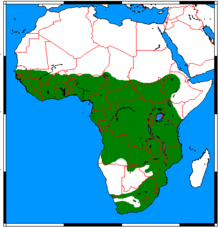Atilax
| Marsh mongoose | |
|---|---|
 |
|
| Scientific classification | |
| Kingdom: | Animalia |
| Phylum: | Chordata |
| Class: | Mammalia |
| Order: | Carnivora |
| Family: | Herpestidae |
| Subfamily: | Herpestinae |
| Genus: |
Atilax F. Cuvier, 1826 |
| Species: | A. paludinosus |
| Binomial name | |
|
Atilax paludinosus Cuvier, 1829 |
|
 |
|
The marsh mongoose or water mongoose (Atilax paludinosus) is a medium-sized mammal, but a large mongoose. Its weight can range from 2 to 5.5 kg (4.4 to 12.1 lb), with an average range of 2.5 to 4.1 kg (5.5 to 9.0 lb). From the head to the base of the tail, these animals range from 44 to 62 cm (17 to 24 in), with the tail adding 25–36 cm (9.8–14.2 in). It is a member of the mongoose family and the only member of its genus. Atilax paludinosus is found throughout sub-Saharan Africa, with a preference for permanent freshwater habitats bordered by dense vegetation, such as marshes, reed beds, and estuaries (though sightings have been recorded in hilly areas with little or no aquatic wildlife presence). The marsh mongoose is an important member of the community of animals inhabiting the papyrus swamps, where deoxygenated water limits aquatic life to various air-breathing fish, frogs, insect larvae, snails, and mammals.
The marsh mongoose's dark brown fur, with black-tipped guard hair, is long and coarse on the body. The paws, unwebbed with underdeveloped pads, are soft and sensitive, resembling those of a raccoon, with the thumb passively enhancing grip on slippery surfaces. The claws are short and blunt and used for digging . There is little hair around the anus and on the upper lip. Typically, there are two pairs of mammae. The lower canines are well formed, while the premolar teeth are thick and used for crushing hard foods. The thick tail narrows shortly to a point.
The marsh mongoose is a voracious omnivore, consuming any form of meat it can catch, as well as a wide variety of fruit. This mongoose will frequently swim along river banks, its head above the water, patiently and methodically sifting through underwater holes and crevices looking for aquatic animals to eat. An intelligent creature, the marsh mongoose has been observed throwing crabs and snails against rocks in order to break open the shells. Some accounts claim that the marsh mongoose will sometimes lie very still, its tail up, and that in this position, the pink anal region makes a startling contrast against the dark fur, which induces birds to come near and peck at it; when the birds come near, they are killed and consumed.
...
Wikipedia

